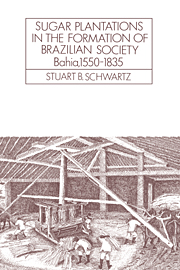Book contents
- Frontmatter
- Contents
- List of figures, maps, and tables
- Preface
- Abbreviations and special terms
- Weights and measures
- Dedication
- Part I Formations, 1500–1600
- 1 The sugar plantation: from the Old World to the New
- 2 A wasted generation: commercial agriculture and Indian laborers
- 3 First slavery: from Indian to African
- Part II The Bahian engenhos and their world
- Part III Sugar society
- Part IV Reorientation and persistence, 1750–1835
- Appendixes
- Notes
- Glossary
- Sources and selected bibliography
- Sources of figures
- Index
- CAMBRIDGE LATIN AMERICAN STUDIES IN PRINT
2 - A wasted generation: commercial agriculture and Indian laborers
Published online by Cambridge University Press: 05 May 2010
- Frontmatter
- Contents
- List of figures, maps, and tables
- Preface
- Abbreviations and special terms
- Weights and measures
- Dedication
- Part I Formations, 1500–1600
- 1 The sugar plantation: from the Old World to the New
- 2 A wasted generation: commercial agriculture and Indian laborers
- 3 First slavery: from Indian to African
- Part II The Bahian engenhos and their world
- Part III Sugar society
- Part IV Reorientation and persistence, 1750–1835
- Appendixes
- Notes
- Glossary
- Sources and selected bibliography
- Sources of figures
- Index
- CAMBRIDGE LATIN AMERICAN STUDIES IN PRINT
Summary
… for one never believed that so many people would ever be used up, let alone in such a short time.
Father José de Anchieta (Bahia, 1564)The early Brazilian sugar economy was tragically related to the history of Portuguese–Indian contacts along the coast. Indian enslavement and their work in canefield and mill proved to be a transitory stage in the sugar industry's development, the use of a relatively inexpensive and readily available labor force during a period before the industry was fully capitalized. Eventually, other workers would fill the ranks of the engenhos' labor force as African slaves, cargo in a voluminous branch of the Atlantic trade, replaced Indians in the late sixteenth and early seventeenth centuries. But the process was gradual and never inevitable. Indian slavery withered away because of the cultural perceptions and limitations of both Indians and Europeans, the susceptibility of native Americans to Old World diseases, and the course of historical events. In Bahia, Indians constituted the main labor source for nearly a century, and even after their replacement by African slaves, Indians could be found on plantations and around them as coerced workers, peasants, or wage earners.
This chapter will trace the history of the relationship between Indians and the Bahian plantation economy. The story is essential for an understanding of the Bahian sugar economy's origins, but it is also interesting in a broader perspective because it casts some light on notions that particular labor forms that developed in colonial areas were, in a sense, predetermined by the logic of European capitalist development.
- Type
- Chapter
- Information
- Sugar Plantations in the Formation of Brazilian SocietyBahia, 1550–1835, pp. 28 - 50Publisher: Cambridge University PressPrint publication year: 1986



